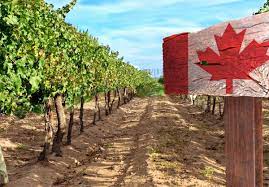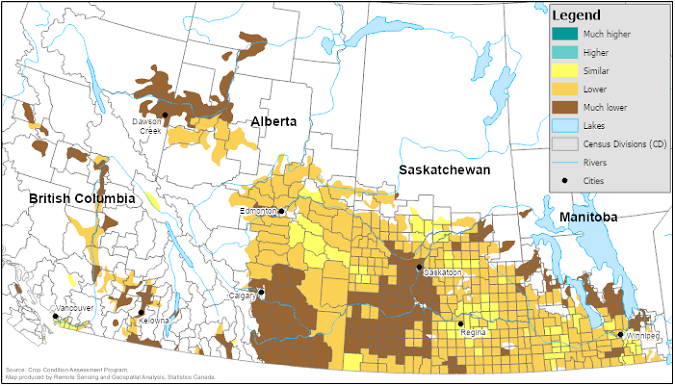The wildfires that are happening on the western coast of Canada will have a profound effect on the GDP production of the economy. None more so than the farming community.
In 2023, Canadian farmers are projected to produce more corn for grain and soybeans, but less wheat, canola, barley and oats, compared with 2022, according to a recent yield model estimates using satellite imagery and agroclimatic data. Decreased production for most crops was driven by lower yields because of dry conditions in Western Canada.

Across much of the Prairies, lower-than-average precipitation and high temperatures have resulted in poorer crop conditions than in 2022. In Alberta, provincial reports indicated that less than half (43.1%) of the total crop was rated as being in good to excellent condition at the end of July, well below the five-year average of (60.2%). In Saskatchewan, dry conditions continue to be a concern, most notably in the southwest and west-central regions. Provincial reports from Manitoba indicated that crop conditions in the province were generally good.
In Eastern Canada, most of Ontario, Quebec and the Atlantic provinces have received higher-than-average rainfall since the beginning of the growing season. In general, temperatures over the last month of the growing season have been slightly warmer than normal.
Statistics Canada has relied on proven satellite technology and agroclimatic data to model preliminary crop yields and production for several years. These methods have successfully been used to produce modelled estimates since 2016. Final harvested area estimates based on the November 2023 Field Crop Survey will be published on December 4, 2023.
The Crop Condition Assessment Program indicates that overall plant health in the Prairie provinces was lower- to much lower-than-normal at the end of July, indicating the possibility of lower- to much lower-than-normal yields.
An assessment of the Normalized Difference Vegetation Index curves, which are a measure of plant health, indicated that crops reached peak health ahead of normal. In most parts of the Prairies, crops reached peak health several weeks ahead of normal crop development, before decreasing rapidly as a lack of moisture and high temperatures took a toll on plant health.
Crop development in Eastern Canada ranged from similar- to lower-than-normal.
Wheat production is expected to decrease as yields fall
Nationally, wheat production is projected to decrease by 14.2% year over year to 29.5 million tonnes in 2023. The decrease is due to lower yields, which are expected to fall by 18.6% to 41.2 bushels per acre because of dry conditions across the Prairies, offsetting higher anticipated harvested area, which is expected to rise 5.6% to 26.3 million acres.
The anticipated decrease in total wheat production is largely attributable to spring wheat, which is anticipated to fall by 14.5% to 22.1 million tonnes. Spring wheat yields are anticipated to fall by 19.9% to 42.6 bushels per acre, while harvested area is expected to increase by 6.9% to 19.1 million acres.
Durum wheat harvested area is expected to decrease by 1.5% to 5.8 million acres, while yields are anticipated to fall 25.3% to 26.8 bushels per acre, contributing to lower anticipated durum wheat production (-26.4% to 4.3 million tonnes).
Wheat harvested area in Saskatchewan is projected to rise by 5.9%, while yields are expected to fall by 25.0% to 32.1 bushels per acre in 2023, resulting in a 20.5% decrease in production, to 12.1 million tonnes.
Wheat production in Alberta is projected to decrease by 16.2% to 9.5 million tonnes, compared with 2022, the result of lower anticipated yields (-18.7% to 45.2 bushels per acre), offsetting higher harvested area, which is expected to rise by 3.1% to 7.7 million acres.
In Manitoba, wheat harvested area is expected to rise by 6.2% to 3.2 million acres, while yields are anticipated to decrease by 8.1% to 53.4 bushels per acre. Total wheat production is anticipated to fall by 2.2% year over year to 4.7 million tonnes.
Wheat production in Ontario (the majority of which is winter wheat) is projected to rise by 13.3% to 2.7 million tonnes year over year on higher harvested acres (+21.3%), offsetting lower yields (-6.5%).
Lower yields push canola production down
Nationally, canola production is expected to fall by 6.1% to 17.6 million tonnes in 2023. The anticipated decrease in production is due to lower yields, which are expected to fall 8.8% to 35.4 bushels per acre, while the harvested area is expected to increase 3.0% to 21.9 million acres.
Saskatchewan is expected to produce 6.3% less canola in 2023 than in 2022, at 9.1 million tonnes. Yields are projected to decrease by 13.9% to 32.7 bushels per acre, while harvested area is expected to rise by 8.7% to 12.3 million acres.
Canola production in Alberta is expected to decrease by 1.2% to 5.5 million tonnes. The decrease is the result of lower anticipated harvested area (-3.0% to 6.3 million acres), offsetting an expected 1.8% increase in yield to 38.8 bushels per acre.
In Manitoba, yields are expected to decrease 9.5% to 39.2 bushels per acre, while the harvested area is anticipated to fall 4.1% to 3.1 million acres, resulting in a 13.3% production decrease to 2.7 million tonnes.
Corn for grain production is projected to increase
Nationally, corn for grain production is projected to increase by 1.3% to 14.7 million tonnes in 2023. Yield is anticipated to fall to 156.1 bushels per acre (-2.7%), while harvested area is expected to rise to 3.7 million acres (+4.1%).
In Ontario, the largest corn-for-grain-producing province, production is expected to rise by 1.3% to 9.6 million tonnes on higher anticipated yields (+2.2% to 169.7 bushels per acre), offsetting lower anticipated harvested area (-0.9% to 2.2 million acres).
Corn for grain production in Quebec is projected to fall by 4.2% to 3.4 million tonnes. Yields are expected to fall by 5.0% to 150.4 bushels per acre, while harvested area is expected to increase by 0.8% to 893,100 acres.
In Manitoba, production of corn for grain is expected to rise 13.4% to 1.5 million tonnes because of higher anticipated harvested area (+42.1% to 528,600 acres), offsetting lower anticipated yields (-20.2% to 112.5 bushels per acre).

Soybean production is expected to rise due to higher harvested areas
Nationally, soybean production is projected to increase by 2.9% year over year to 6.7 million tonnes in 2023. Yields are expected to fall by 3.5% to 44.3 bushels per acre, while harvested area is anticipated to increase by 6.8% to 5.6 million acres.
Soybean production in Ontario is expected to edge down 0.2% in 2023 to 4.0 million tonnes. Harvested area is expected to fall by 5.1% to 2.9 million acres, while yields are anticipated to rise 5.2% to 50.5 bushels per acre.
In Manitoba, soybean production is projected to increase by 4.5% to 1.4 million tonnes in 2023. Harvested area is projected to increase by 39.8% to 1.6 million acres. However, yields are projected to fall by 25.3% year over year to 32.1 bushels per acre, likely because of moisture conditions.
In Quebec, soybean production is projected to increase by 12.7% to 1.3 million tonnes on higher anticipated yields (+7.1% to 46.8 bushels per acre), while the harvested area is expected to rise by 5.3% to 996,000 acres.
Barley and oat production is projected to fall
Lower barley yields (-21.4% to 55.3 bushels per acre) in 2023, compared with 2022, are projected to more than offset higher anticipated harvested area (+1.0% to 6.6 million acres). As a result, barley production is expected to fall by 20.7% year over year to 7.9 million tonnes in 2023.
Oat production is projected to fall by 53.5% to 2.4 million tonnes, the lowest production in more than a decade. The decrease is attributable to lower harvested area, which is expected to fall by 40.9% to 2.0 million acres, and lower yields, which are expected to fall by 21.4% year over year to 76.9 bushels per acre in 2023.
Note to readers
This release provides the preliminary production estimates for 2023. The estimates are produced using model-based data.
The approaches employed in producing these estimates are in line with the AgZero initiative underway at Statistics Canada, which aims to produce high-quality estimates using modelling, administrative data, and other non-traditional survey-based approaches.
The Field Crop Reporting Series produces data from Quebec, Ontario, Manitoba, Saskatchewan and Alberta for all occasions during the crop year (from March to December). However, data are collected twice a year (in the June field crop survey on seeded areas and in the November field crop survey on final crop production) for Newfoundland and Labrador, Prince Edward Island, Nova Scotia, New Brunswick and British Columbia, which represent between 2% and 4% of national totals.
As of July 2014, for these provinces, July production estimates are calculated using the final estimates of the last three crop years. The harvested area is first estimated based on the ratio obtained from the sum of harvested areas of the last three years over the sum of the seeded areas of the last three years. This average ratio is applied to their current year’s seeded acreage from the June survey. This harvested area is then multiplied by the average yield of the last three years to estimate production.






